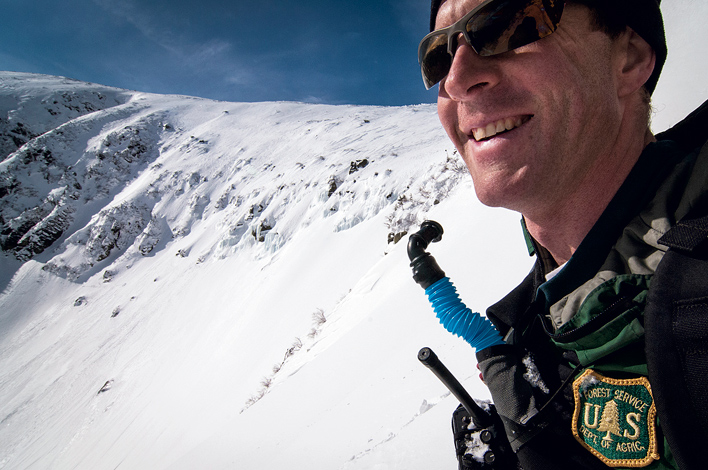In spite of the prominence of New Hampshire’s Tuckerman Ravine as a classic spring-skiing destination, the U.S. Forest Service has closed access to Mt. Washington’s east side and the Mt. Washington Avalanche Center has ceased forecasting for the season, instead urging visitors to stay off Mt. Washington in accordance with New Hampshire’s Stay at Home order that’s part of the state’s response to the COVID-19 pandemic. While it’s not quite the same as a spring day spent in Tucks, Backcountry’s Boundless Issue (#133) features a 24-page deep dive into the history of skiing on Mt. Washington—purchase a copy of the issue now at shop.holpublications.com with free shipping or download the digital version for just $3.50.
Here’s an essay that’s excerpted from the feature.
It’s no secret that backcountry skiing has seen a surge in popularity. This overall trend is clearly visible on Mt. Washington and around the Presidential Range, where I’ve been working for nearly two decades. And while the numbers have swelled, the critical safety messages being delivered to visitors have remained surprisingly consistent despite huge changes in visitor use patterns.

In the early 2000s, Tuckerman Ravine was primarily an ice-climbing destination until mid-winter, when the snow finally covered up most of the ice. Few skiers were traveling beyond Tucks and Gulf of Slides. The base road to the west side wasn’t consistently plowed until 2004, and the Cog Railway hadn’t yet cleaned up the decades’ worth of debris littering the tracksides, so almost nobody was going in that way beyond a core group that was happy to put in extra miles in exchange for solitude. Then springtime would roll around, the resorts would start to shut down, and the annual ski orgy in Tuckerman would begin.
Fast forward to 2020. Skiers are everywhere. Each weekend you’ll see several avalanche classes, and the groups are dominated by relative newcomers to the sport. For contrast, in 2003 there were only seven Level One avalanche classes offered on Mt. Washington in an entire season. Any given day now, however, you’ll see a constant parade of skiers heading for the Sherburne Trail. Skiers are hitting the ravine itself early and often, too, and runs like Left Gully and Chute that are skiable as early as November now have numerous descents before Christmas. Huntington Ravine, historically an ice climber’s destination, is almost as much a skiers’ ravine as one for climbers. All across the Presidentials and even well beyond, skiers are exploring throughout the winter months.
What might not be obvious to everyone, but clearly helps Mt. Washington have its own unique identity, are the invaluable partnerships that exist between government agencies such as the U.S. Forest Service and New Hampshire Fish & Game; nonprofits like the Appalachian Mountain Club and Mt. Washington Observatory; and volunteer groups like the Mt. Washington Volunteer Ski Patrol and Mountain Rescue Service. These groups all have their own missions but share the common thread of keeping us safe, a goal that’s ever more important as the surge is showing no signs of ending.
In 2018, probably the most significant avalanche- related improvement occurred with the change from slope-scale forecasting—where rangers rated the danger for each specific avalanche path for only Tuckerman and Huntington Ravines—to range-scale forecasting across the Presidentials, encompassing a much larger geographic area and similar to the practice of other avalanche centers in the U.S. This was not a hasty decision: as the oldest forecasting center in the country there was a long and storied history behind the microscale forecasts. Overall this change has been well received by the community, and hopefully the extended range is helping people avoid avalanche trouble.
The core safety information provided by the USFS snow rangers hasn’t changed much in the past 20 years. In addition to reporting on the avalanche hazard, they continue to tell about bad weather and unexpected events and to caution about long, sliding falls on icy slopes and other common Mt. Washington hazards. The avalanche center website is still the primary vehicle for delivering safety information to the masses, but they also have increased the use of social media to keep people aware and engaged. In the comment sections, you’ll increasingly find an open discussion taking place between the snow rangers and the public, marking a shift from a one-way safety information system to more dynamic, more visible two-way communications, which includes the opportunity to submit observations directly to the snow rangers.
I’m pleased to see the ongoing evolution of the avalanche center. As an educator, I’m thrilled to see classes filled to capacity with students new to backcountry travel. This tells me that there’s a cultural shift taking place that is bigger than the expansion in numbers, a shift where getting an avalanche education is now widely considered an important step in being a backcountry skier.
The challenge, now as much as ever, is in figuring out ways for the critical information to reach those who don’t even know they need it. I doubt this challenge will ever go away entirely. Ken Kesey once said, “In any given situation there’s going to be more dumb people than smart people.” I don’t necessarily think he’s wrong, but I’d like to think the backcountry community might become an exception to this rule.
—
Jeff Lane’s career on Mt. Washington began in 2002 as the AMC’s Hermit Lake caretaker. In 2006 he became a USFS snow ranger and met his future wife while sipping coffee on a Saturday morning at the snow ranger cabin. He left the Mt. Washington Avalanche Center in 2016 to become a part-time avalanche educator and full-time father of two. This essay first appeared in Backcountry’s Boundless Issue (#133).










Related posts:
History on the Headwall: Mt. Washington’s Tuckerman Ravine
Mt. Washington’s Great White North
Inside New Hampshire’s Craft Glading Movement